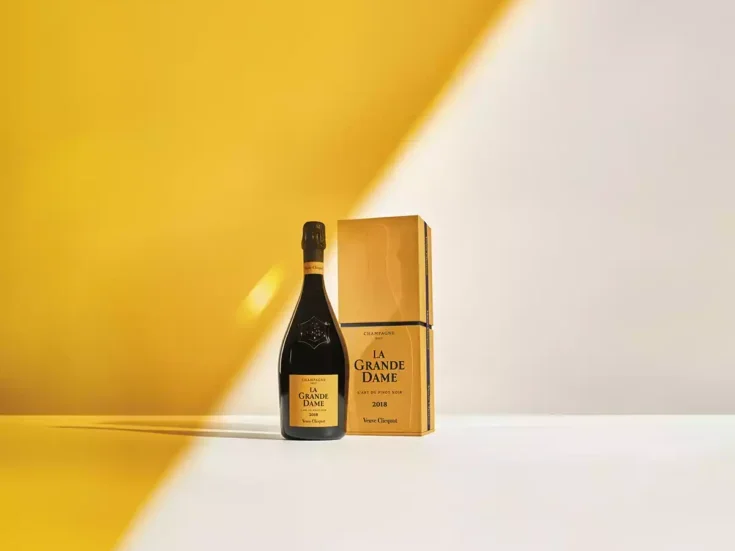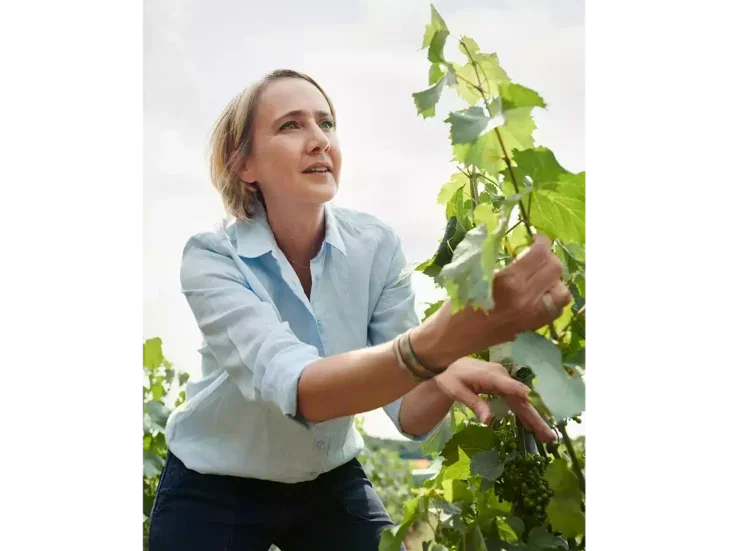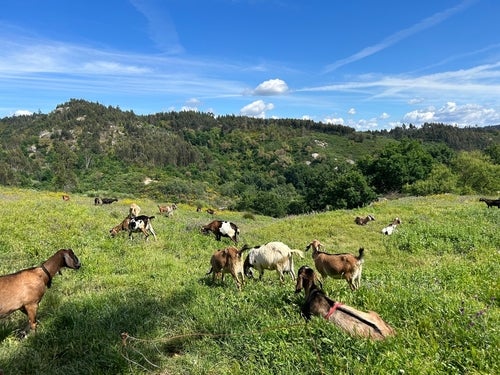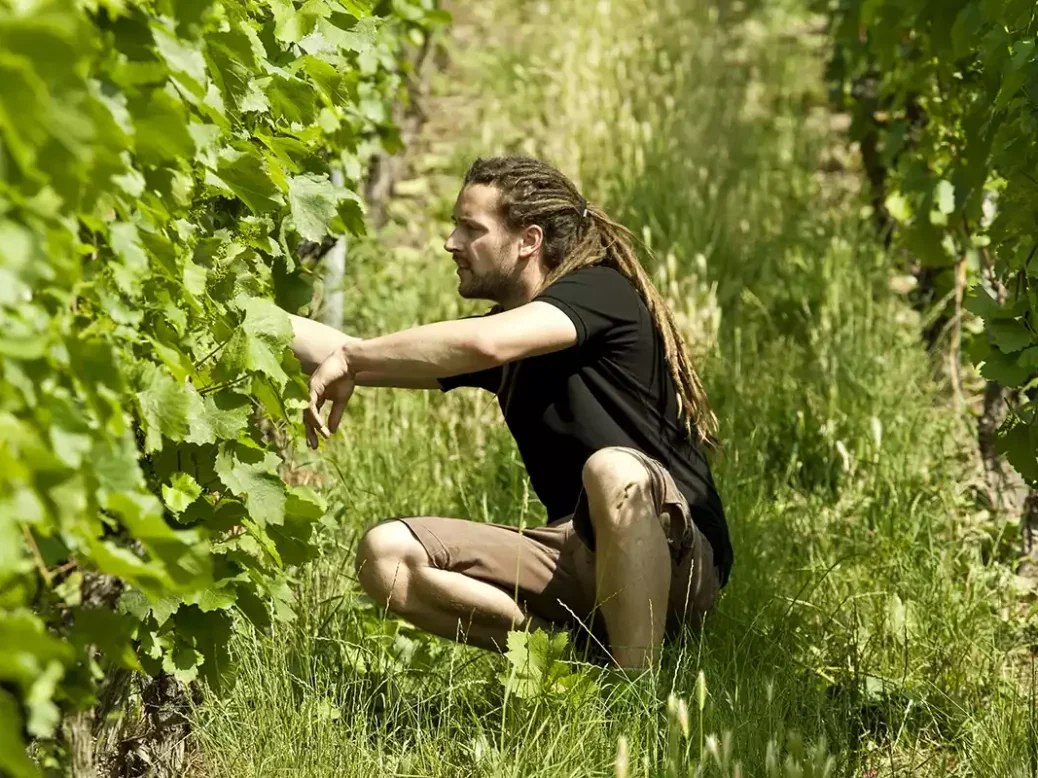
Dautel is the story of today’s Württemberg in microcosm. It’s also the story of the contemporary wine drinker, who are fewer in number and more exacting in standards of quality. The “old” Württemberg, dominated by co-ops producing decent plonk which the locals consumed easily, eagerly, and for the most part indifferently, has been superseded by a far smaller range of fine to excellent growers selling their wine to a community of epicures.
Dautel and the poetry of sticks
Christian Dautel’s father was among the first to smash the old mold. In doing so he followed a familiar pattern; cutting and pasting sensibilities he observed in his travels to other (mostly French) wine regions. I didn’t know the wines then, but I’m told they were effective of their type and time, and Christian has great respect for his father’s efforts, and the two generations work together seamlessly.
Today’s Dautel wines have less alcohol and less wood—or in any case less overt wood—and like many smart producers he seeks to make wines with flavors arising from within rather than flavors affixed from without. His Pinot Noirs are not only wholesome, sophisticated and graceful; they come from a vintner who appreciates the viscera of red Burgundy and applies that frame of reference to his own wines. They are not at all facsimiles of Burgundy. They are German PN made by a man who gets Burgundy.
The traditional varieties—in this case Lemberger, Trollinger, and Pinot Blanc—are so elevated in quality the drinker of 30 years ago wouldn’t recognize them as Württemberg. The Rieslings move seamlessly into the highest echelon of German Riesling. Though I didn’t taste them this time, his sparkling wines are first class.
There were 28 wines in all, consisting of two vintages of each wine in the range of PN, Chardonnay, Lemberger, Pinot Blanc, and Riesling. My first run through them took me five days, and in effect I’ve been living with Weingut Dautel for the last 12 days and for the next ten too, from all appearances. I’ve had very few wines other than these, since tasting the first bottle. They continue to be joyful, interesting, and useful. None has deteriorated and many have improved.
Dautel is the kind of estate to reassures us that wine is in good hands. Not just “his” wines or the region’s wines—wine. Craft and intuition and a nearly unerring sense of taste and proportion are found here. That, plus the guy is down to earth and funny.
2022 Dautel Trollinger
As you know, this is either Schiava or Vernatsch depending on whether you’re north or south of Bolzano. In either case it can be an addictive gulper, with the classic “can be served cool” phrase we use for wines like this. (I’m tasting it at 60°F [15.5°C], as it happens.)
Screwcap can (and does) give a wee reductive burp, whose rudeness we approve of in some odd way. The seduction only occurs in the mid-palate, where the helplessly appealing fruit first shows. The wine is initially (and atypically) gravelly—almost tannic—what we usually call “structure,” which connotes a nubby sort of tautness.
The wine is lovely but different than usual, based I think on the general tendency of ’22 to a certain grit. Trollinger is a chipper wine, with its mélange of tomato water, violets, and tomato leaf, but ’22 seems to be a logy sort of year for it. I’d drink it pleasurably but a little less joyfully than usual. It’s like it had been admonished by teacher for its disruptive high spirits and now it’s sitting still and behaving. We’ll see if it comes to life and throws a few spitballs over the days.
The reduction vanished with time. That’s no surprise. What I couldn’t predict was how the wine would revert to form, such that when I unscrewed the cap on day-seven the sweet fragrance filled the room. It had fleshed out in every way and turned into an analogue for an especially fetching Bardolino. The final third of this bottle will be gulped down.
Dautel Lembergers
This is a quartet, two vintages each of the premier crus and then the GG. This is Württemberg’s traditional red grape, also known as Blaufränkisch, though to me it tastes more like old-style Cahors, ie, Malbec with Old World structure and coolness. It is of the “claret” paradigm, vertical where the Pinot Noirs are (as a rule) more spherical.
2021 Lemberger Sonnenberg, Bönnigheim +
You know how a wine can sometimes just smell alive? This one does. It also smells enticingly complex from the Jancis glass.
It’s cool, almost aloof at first. 2021’s tendency to show obdurate acidity (which gave me doubts among some of the Rieslings) is tempered the farther south you go, and can also be welcome among the reds. Here you can basically queue up all the “usual” descriptors and take roll call. They’re all standing at attention waiting for their names to be called. “Violets!” Sir, yes SIR! “Blackberries!” Sir, yes SIR!
I love it. The wine refuses to ingratiate itself. It just osmoses its nonchalant complexity and is indifferent to the “impression” it makes. But whew, it impresses the living hell out of me; the sheer density of tangible extract gives it an implosive intricacy of mints and resins, anchored to an allusively sweet fruit. But I must emphasize the wine is only indirectly fruity, and gains its stature from an almost febrile rendering of every other varietal flavor.
If you’re ever lucky enough to have this and the 2019 side by side, you can see the Alpha and Omega of Lemberger. And as you let this one sit in the glass you get to see the emergence of cloves and carob and funky irises.
This is about as impressive as a wine can be that doesn’t have an ounce of seductiveness. And yet the tertiary finish is almost blissfully delicious. The last gesture, amazingly, is intensely floral.
I once told Valerie Kathawala (of TRINK mag, which you really should subscribe to) that I disputed the notion that Pinot Noir was the “red Riesling.” What was it then? “It’s Blaufränkisch,” I said, and here’s a wine that says why as convincingly as can be conceived. It’s the perfect analogue to all of Riesling’s particular virtues. Taste and believe.
2020 Lemberger Sonnenberg, Bönnigheim +
Most drinkers will find this more attractive. Hell, I too find it more “attractive” if it comes to that. It leads with suavity and it’s tenderer and more avuncular. My pals at Recchiuti chocolate (in San Francisco—a shout out to them!) have a bar they call “dark milk” which splits the difference, and which is an abiding citizen of our household. This wine is like that chocolate.
Maybe I’m naïve—I don’t taste a lot of Bordeaux (or any, actually) and I barely ever drink Cabernet—but this wine really has The Goods. It’s more pliant than the ’21 but you wouldn’t call it soft. It basically rearranged the constituents of the younger vintage, ie, it leads with fruit and all the herbal/mineral juju brings up the rear, and all in a more relaxed at-easemanner.
But it’s also a sophisticated wine with “mature” tannin, and almost a truffley earthiness. In place of the explicit intricacy of the ’21 this has a sweeter umami. It’s more lavish, more sensual, and while it’s less cerebral than the ’21 it is entirely cerebral enough.
It took a week for any oxidation to creep into a nearly empty bottle (we’d consumed it happily, and several times). As a nuance it’s not disagreeable. Nor will finishing the bottle promptly pose any sort of problem!
Quite a pair.
2021 Lemberger Michaelsberg, Cleebronn +
Annoyingly, this only says “Lemberger” off to the side, and you only know it’s a GG by the embossed bottle, which also seems….heavier than it might be. These affectations are puerile and really ought to stop. I get the “philosophy” behind the practice (“It just says Bonnes Mares on the Burgundy label without saying it’s from Chambolle-Musigny…”) but I would advise that HELPING THE CONSUMER takes precedence over enacting whatever metaphysics you think you need to do with the label. But do please continue to ignore me.)
It’s more intense than the premiers crus. “Intense,” by which you infer its significance. It’s also a little funkier, which I don’t mind. Funny; I’m the antithesis of the usual drinker, who approaches the “GG” expecting something lofty and profound, whereas I expect a simulacrum of that experience and need to be persuaded it is authentic. This is probably not fair, nor is it reasonable, but in my feeble defense it is prompted by the affectations attached to the category, starting with the heavy bottles.
Enough ranting—how good is the wine? The wine is seriously excellent, and I’ll try telling you how. It presents with a sort of seethe of intensity which impresses because it isimpressive, but whether it is more aesthetically valuable than the clarity and easy grace of the premiers crus is … an open question.
But don’t let me ignore how VERY GOOD THIS WINE IS. Its concentration is valid, it isn’t driven by oak or excessive tannin, and it’s honestly concentrated and as strong as Samson. There’s a lot to admire, not least of which are the (typical) mistakes it DID NOT MAKE. Chief among them is a form of “concentration” that can sometimes feel immaturely assertive, and that is not the case here. In fact the wine grew in grace and cogency the longer it was open.
But with that in mind, what about the whole “GG’ matter? I mean, if you assert a grand cru you have to back up both the assertion and the price you charge for the actual wine, and I wonder, often, whether one does that with external affectations of the “significance” the category (and price) suggests. Because what I am tasting here is an excellently rendered wine of strength, honestly justified and without recourse to all the ancillary bullshit these wines are often subjected to—but what I am not tasting is a particularity of “Michaelsberg-ness” whereby the cru displays its cru-ness.
I apologize to Christian Dautel and his truly wonderful wine for obtruding with all my bloody opinions! My issues aren’t with him, but with the system that encloses him. He’s my hero.
2020 Dautel Lemberger Michaelsberg, Cleebronn ++
Same kvetches as above. Interestingly also, the same initial funk, in both cases fleeting.
They say there’s an overlap (especially over time) between Lemberger (Blaufränkisch) and Pinot Noir, and you can sense it here. Sniffing this from the Riedel (Chianti Classico) glass, you couldn’t be certain which variety it is. The Jancis makes it clearer, as the Jancis is wont to do.
In this case the GG designation is buttressed by an ethereality the ’21 didn’t (and couldn’t) show. Yes there is intensity, but also a confidently relaxed lingering mid palate flavor and a para-sensual “sweetness” I wasn’t sure Lemberger could show.
In effect what I’m saying is that “GG” shouldn’t announce itself by greater intensity but instead, as this one does, by greater beauty. Maybe the ’21 vintage precluded this. We certainly see it here. I mean, elementally it would be possible to line up the associations, though it would bore me, but what I think is salient is, this wine delivers the proper combination of disciplined power, fruit sweetness, a firm yet rich structure, creating an overall sort of 3-ring circus of flavor whereby it satisfies on every level. Because what we want is the yum experience that isn’t merely yum, but brings with it all manner of intricate doo-dads, that make us think “It’s THIS—no, it’s THAT—no, it’s SOMETHING ELSE…”
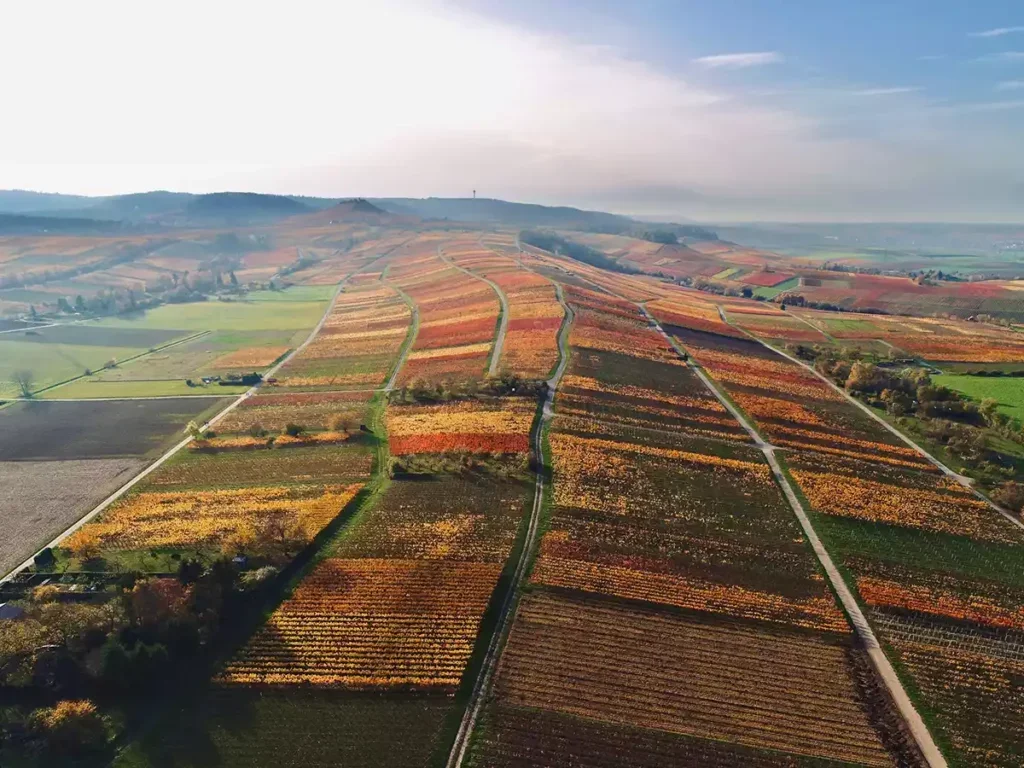
Dautel Rieslings
I actually tasted these last, though I feel it makes more sense to place them here. After five days of immersion in the “Pinot Types” (red and white) and the fine Lembergers, I’d nearly forgotten that Dautel makes Rieslings, and it is a total blast to remember how superb they are.
Here’s a little mise en scene. The second time I taste these it’s part of a re-taste of the whole range, and I’m tasting the Rieslings at the end. I poured the first wine right after the Weissburgunder -S- and you can hardly imagine two more disparate wines. It is also about to storm outside, and since I taste outside I’m awash in petrichor and a sudden cool wet wind. The house is darkening….and there’s the first rumble. My phone says it will rain in nine minutes. A ridiculously fresh Riesling is in my glass.
2023 Riesling
The estate-level wine, like all but one of the Rieslings, only says “trocken” on the side label.
This is delightfully spritzy (a characteristic I like) and shows the juniper and radish snap we follow all the way up to the GG. Christian Dautel calls it the gin and tonic flavor and one knows what he means.
The wine is stupid-good, especially from the Jancis glass; it’s on the taut side (precluding my “glug-glug-glug” designation) and considering its almost rude vigor it’s actually a rather serious bit of business. Lime, citrus and pepper emerge with air. A sub-audible whisper of sweetness appears to exist. It’s actually okay for the wine to be raspy, to scrape a little.
Look, even “everyday” Riesling begs to be examined and described, but I have a feeling it can go overboard. In another report I wrote “You don’t need great Riesling to show that Riesling is great,” and it’s exactly here, at the basis, without frills or pretensions, that this variety shines an incomparable light.
2022 Riesling +
The yearling has more umami and more tangible fruit, and it. Also has a measure of TDN (the thing sometimes called “petrol,” annoyingly) along with a lavish presentation of the “sweet-green” herbs (wintergreen, verbena, anise hyssop) and an arresting generosity of flavor.
Given my wariness around 2022 in general, I must admit this is an essentially better wine than its baby brother. And it outruns the expectations of its “echelon” to such an extent you have to sit agape at the value it represents. I wonder if he still has any…..but if he doesn’t I really hope you do, because this is about as excellent as such a wine gets.
It’s the mid-palate that carries it. It is simply more swollen with flavor. That sweet-green thing really gushes. It is also not the first time I’ve felt a thread between here and the Wachau, and if I were tasting blind, the Wachau would be my guess—and Alzinger would be the grower, and I’d only be wrong by, let’s say, around 850 kilometers.
It’s equally improbable structurally, as all that mid palate is surging along a salty stream of energy, and the finish is like fresh true wasabi. It’s another way for Riesling to be Riesling, one we didn’t used to know but as soon as we taste it we feel like it always belonged and the Riesling gods just forgot it in the back of the car. “Oh man, where’s the Württemberg….did we leave it in the car? Don’t anyone leave until you taste this…”
2023 Riesling Bönnigheim +
The village wine is an original, grown on Gipskeuper etc., and if you still don’t accept the idea of soil creating flavor (you’re a sort of terroir flat-earther, dude), do be my guest and taste this along with the Weissburgunder from the same ground and then claim that variety supersedes soil. Also applaud me for not using the word “trumps” soil. (We do not permit that word in our prose…)
It’s hard to beat this for sheer originality. It could be too arch for some tasters, and one could seek more power. If I’m being fussy I could remark on the clipped phenolic finish.
But pause a minute, and ask yourself when you ever sniffed a wine that smelled like an incense made from osmanthus or that ever drew so close to peppermint without being grosslike peppermint often is. The wine is an angular riot of surpassing (and splendid) weirdness. It’s a craggy masterpiece of stubborn particularity.
Go on, eschew the hedonic just this once. And consider what Riesling can do. The variety has a plastic, adaptable brain and the wines will say things you never thought you would hear.
2022 Riesling Bönnigheim
It has “the ’22 aroma” in common with the estate wine, but layered over with the wildly spicy flavor from the terroir, both cardamom and ginger and also several octaves of pepper, from bell pepper to (barely) smoked paprika to a high-toned peppercorn like Tasmania or even Timut. The overall effect is smoky, or “smoky,” but much more campfire than the blatant aroma of “smoked” foods.
Jumping ahead, the finish is earthy, chewy, “rural.” But from the Jancis glass the suit is pressed and the tie is knotted, albeit the body isn’t quite at ease in it. In that sense it has more of the sometimes-dubious nature of the vintage, a sense of being ill at ease. The minerality displayed from the Jancis glass goes some of the way to reconciling what otherwise feel like disparate parts.
I admire (and love) each of those parts singly, because I cherish distinctiveness above most other attributes. But fit-and-finish also counts for something, and here I feel the pieces might be more seamlessly aligned. This is subject to revision as I taste the wine again, but the gritty finish (typical for ’22) suggests my first impression might persist.
All of this reduces to a question of approach—do we look for something to enjoy, or something to question? This would make a nice casual drink of wine if you focused on its many attractive attributes and opted to ignore the things the “taster” would cavil over. Being the “taster” I sometimes feel a somber sort of guilt about fussing and nitpicking, and the only way to allay it is to insist we distinguish between judging and slugging down. I disavow nothing I wrote here, but I also remind you it is only a partial truth.
2022 Steingrüben, Bönnigheim GG
The bad news is “Riesling” only appears on the side-label but the good news is, this GG has just 12.5% alc.
Grown in effect on pure Schilfsandstein (on a bed of Gipskeuper itself on a bed of shell-limestone), among the royal court of Riesling GGs in Germany, few could be more original and particular than this one. And with that said, this ’22 seems to embody all-that-these-Rieslings-might-become, without overtly adding an element of its own, that wasn’t present in its predecessors.
There’s a high-altitude brilliance of spearmint and tarragon and there is certainly greater length (and more physiological maturity, registering as umami-driven “sweetness”). There is more intensity, more linger, and more of that pleasurable wash of vinosity that tells us the wine is important (and that rewards the extra price we paid for it), and while all these things are wonderful, I seek the extra thing the other wines did not have.
Perhaps it is found in the gingery high notes, and it is certainly found in the shimmery complex finish. And it suffices, of course, for the wine to be merely excellent—but I have had more convincing vintages. That said, this may be another ’22 that warrants a second and more deliberate look.
I’m taking this now, in mid-thunderstorm. The smaller plants have blown over. The wine is still a little coarse. At 4:19pm our streetlights have come on. The main element of this cru can be tasted—and appreciated—but the overall impact is maladroit.
2021 Steingrüben, Bönnigheim GG ++
Let’s get this out of the way: This is extravagantly fine wine.
That said, what, really, do we make of ’21? As young wines its attributes are not only convincing, they are overwhelmingly so. The galvanic structural brilliance seems to transmit every possible mineral flavor and to elevate “fruit” to some celestial level that is almost out of reach for what we call our “palates.”
My question is—now what?
Reviewers write reviews based on impressions of extremely young wines (as a rule) and on their guesses as to how those wines might develop. When the young wine is so resounding it is terribly easy to assume it is a “great wine” and will always be one. That’s a reasonable guess, a lot of the time. Some types of wines are less wayward and capricious than others.
So the question is—looking at the things that make this wine so compelling, what might become of them? Will the gorgeously herbal and steely flavors this wine shows now become vegetal in ten years? Or will they follow the fir-like coniferousness of the current wine into a soft forest-y sweetness? (And the “98 points” some reviewer would give it -and could defend having given it—actually clouds the issue.)
I am very much aware I have the privilege of mulling these things over because I have a kick-ass wine in my glass. I have never been a reviewer who told you how long you needed to wait to grab a wine at its “best.” That’s because I don’t know and I really don’t think anyone knows. What I can say, truthfully, is that this wine tastes stunningly amazing right now, and I can’t promise it will get better—though it just might.
Meanwhile, why would you walk away from the bliss of drinking this gorgeously uncompromising Riesling this very day? How much more electrifying tingle does anyone need?
2022 Schlipschälde, Bönnigheim ++
It is Riesling. It has 11.5% alc. It is not (therefore) a GG though it is a “VDP Grosse Lage,” and it has an unidentified measure of RS.
The RS was “accidental” at first, but they seem to have liked how it tasted, and it has persisted—though they do not (admirably) tell us how much RS there is. Enough to lower the alcohol by a percent!
In any case the RS is invisible. The wine, though, is scintillating and perfect, the best among the ’22 Rieslings here. Being a ’22, one must allow for the gritty finish—and a little more RS may have ameliorated this. Yet it is also evident that the actual (and undetectable) RS has the effect of pulling the whole ensemble together by dint of the perfect scarf, so to speak. Everything is enhanced—and sugar, like salt, is a flavor enhancer par excellence. Why we never talk about this is an abiding mystery to me.
This beautiful wine is firing on all cylinders. It adds to the juniper and salt its own flavor of plum blossom and (even) beets, and also an extra register of vinosity, of dialogue, which the bone-dry wines (which I love!) cannot show.
It also highlights a kind of wildness that resides in the sweet-acid tension—given that “sweetness” is a behind-the-scenes player. The wine is masterly, and instructive.

